You thought that you were the only one who had to deal with green algae in fish tank, right? I thought so too. However, it turns out that the cause of green algae in the fish tank is more prevalent than what most people expect. It might surprise you to learn that aquariums suffer from algae problems all around the world. The solution is no better than the problem itself and there are numerous ways that people try to fix their fish tanks (which can turn out disastrous for your pet fish).
In this article, I will be sharing all the knowledge that you might wanna know before starting to clean your fish tank algae. So, Let’s start with the most basic question:
- 1 What Causes Fish Tank Algae?
- 2 Fish Tank Algae Types
-
3
Ways to Remove/Reduce Green Algae From Fish Tank?
- 3.1 1- Manual Removal
- 3.2 2- No Direct Sunlight
- 3.3 3- Reduce Light Period
- 3.4 4- Reduce the Light Intensity
- 3.5 5- Cleanup Crew
- 3.6 6- Don’t Overfeed Your Fish
- 3.7 7- Reduce Phosphate, Nitrates, and Silicates
- 3.8 8- Aquarium Algae Eaters (Algae Fish)
- 3.9 9- Frequent Water Changes and Tank Maintenance
- 4 How to Remove Green Algae on Aquarium Glass?
- 5 How Can I Prevent Algae From Getting into My Aquarium?
- 6 Is there any easy way of removing thread algae?
- 7 Can I Use an Algicide to Control Algae?
- 8 How to Handle Fish Tank Algae Bloom?
- 9 What do We Think About Green Algae?
What Causes Fish Tank Algae?
Green algae are naturally occurring and are not a disease, but can be a sign of other problems in your tank. To get rid of green algae, you’ll need to find out what’s causing it.
Here are a few of the causes of algae in fish tank
1- Direct Sunlight
The most likely cause is sunlight hitting the tank, which can cause the algae to bloom. Generally, known as algae bloom in a fish tank If the tank is in direct sunlight, you may need to clean it more frequently than if the tank were in a dark room.
2- Overfeeding Your Fish
Another common point of entry for green algae is overfeeding your pet fish. This can cause excess nutrients that are released into the aquarium water, which can cause the green algae to bloom.
3- Other Live Plants
Finally, if you have live plants in your tank, they will also compete with the algae for nutrients and light. This means that if you have too many live plants or if they are not getting enough nutrients or light, they will be less able to compete with the algae and it could bloom as a result.
While all of these things can cause green algae to appear in your aquarium, it’s important to note that they are all preventable. Which we are going to discuss later in this article.
Fish Tank Algae Types
There are many different types of algae that appear in a fish tank, and it’s important to know what type of algae is present before trying to treat it. Some algae are dangerous and difficult to remove, while other harmless.
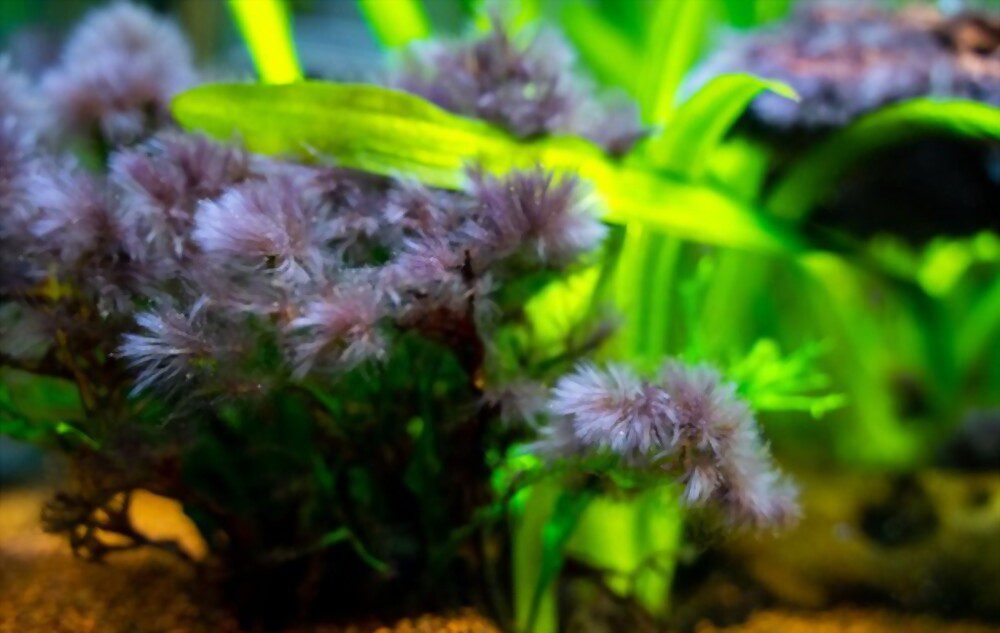
If you take the wrong approach to treating your fish tank, you could kill your fish or damage your aquascape.
The most common types of algae that appear in fish tanks are:
1- Green water, Which is caused by high nitrate levels in the aquarium water. In most cases, green water doesn’t harm your fish
2- Blue-green algae, which is actually a type of bacteria, can poison fish or clog filters if left untreated.
3- Hair Algae, Which is perhaps the easiest type to identify because it looks like hair! Hair algae usually appear on decorations or plants inside the tank.
4- Black Beard Algae, Which grows on rocks, driftwood, and other decorations in the tank. Black beard algae look like black fur and can be hard to remove once established.
5- Brown Algae, It also appears on rocks, driftwood, and other decorations in your tank. Brown Algae looks like rust.
Ways to Remove/Reduce Green Algae From Fish Tank?
1- Manual Removal
Manual removal of green algae from fish tanks is a very time-consuming and risky process. We recommend don’t take this approach if you are a beginner in the aquarium hobby. But if you feel comfortable then you can definitely go ahead with this method.
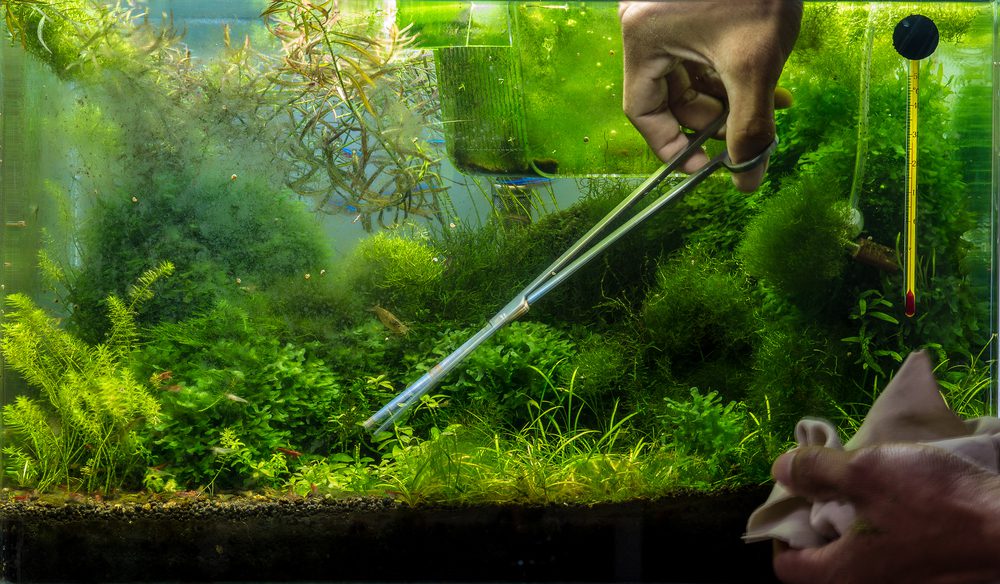
Just follow these steps and everything will be fine:
Step 1: Drain your tank. Be sure to remove all of your fish and other aquatic life before you do this.
Step 2: Put on some rubber gloves and scrub the sides of the tank with a sponge or a soft-bristled brush to get rid of the algae. If you use a sponge or brush that hasn’t been used for anything else, you can wash it with hot water and dish soap and then let it air dry before using it again on your tank. Be careful not to use any cleaning products that contain algaecide, chlorine, or other chemicals that might harm your fish or plants when you refill the tank.
Step 3: Refill your tank with clean water from a safe source. Tap water is usually fine, but if you have any questions about whether the tap water in your area is safe for fish, consult with your local pet store or an aquarium supply company online before adding it to your tank.
2- No Direct Sunlight
While green algae can be a pretty addition to your tank, it can also grow out of control, and then it can begin to create problems for the other organisms in your tank.
If you want to avoid green algae growing in fish tank, one option is to reduce the amount of sunlight that comes into your fish tank. This can be easily done by covering your windows with curtains.
You can also purchase an opaque hood or cover for your fish tank, which will keep sunlight out even if your fish tank sits near a window that gets lots of sunlight.
You may also want to move other sources of light away from your fish tank by relocating the fish tank (Only If Possible).
3- Reduce Light Period
Limiting the amount of time your tank is exposed to sunlight is a valuable method of reducing the number of green algae in your tank.
Shorter periods of sunlight exposure will reduce the photosynthesis process thus reducing the number of green algae present in your tank.
4- Reduce the Light Intensity
If you want to reduce the number of green algae in your fish tank, you’ll need to lower the intensity of sunlight to which your tank is exposed to. In general, keeping your tank in a room that receives natural light from windows is enough to prevent this issue.
If you’re finding that your tank is receiving too much sunlight, consider changing the angle of your blinds so that less sunlight enters during peak daylight hours. Alternatively, take out any artificial lights you might have in the room and leave them off for a few weeks.
5- Cleanup Crew
A cleanup crew is a combination of snails, crabs, and shrimp that eat the food that your fish leave behind. The cleanup crew also eats any waste your fish produce.
The cleanup crew includes:
- Algae Blenny
- Amano Shrimp
- Assassin Snail
- Bristlenose Pleco
- Cherry Shrimp
- Ghost Shrimp
- Nerite Snail
Your fish tank must be set up for at least six months before adding a cleanup crew. If you have both live plants and coral in your tank, don’t add a cleanup crew. They will eat the plants and coral, which are beneficial for your tank.
But If you want a fish tank with less green algae, you should add a cleanup crew to your tank.
6- Don’t Overfeed Your Fish
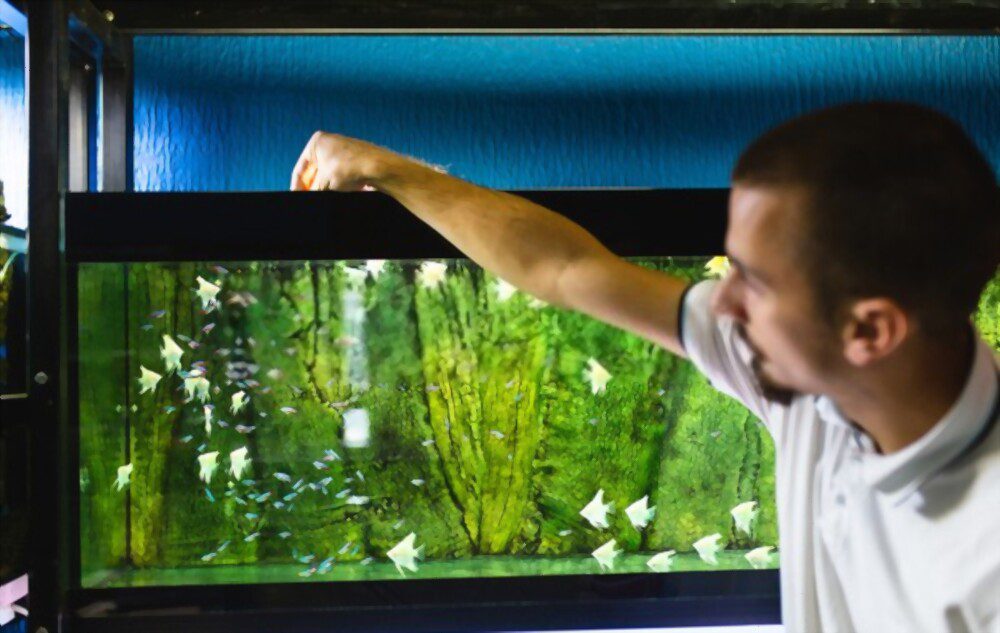
We recommend trying to reduce the amount of food that you give to your fish. It may seem like you’re being cruel and depriving your fish of their favorite mealtime, but the truth is that most people overfeed their fish. Fish don’t need more than one meal per day, usually only a few flakes or pellets, and if you give them more than that, it’s possible that leftover food will end up as waste in the water, which could encourage algae growth.
So if you’ve tried other methods with no success and you have been battling algae fish tank, try cutting back on the number of meals for your fish. It just might do the trick!
7- Reduce Phosphate, Nitrates, and Silicates
Try reducing phosphate and nitrate levels in your tank. Some types of fish food are high in phosphates and nitrates, so if you’re feeding your fish often, you may want to scale back on the amount you feed them. You can also use aquarium filter media that traps phosphates and nitrates.
Another option is to reduce silicates in your tank. These can be added to your tank when preparing tap water for use in the aquarium. To avoid adding silicates to the water, use reverse osmosis or deionization filters when prepping tap water for the fish tank. You can also add zeolite media to your aquarium filter system to adsorb silicate from the water.
8- Aquarium Algae Eaters (Algae Fish)
Aquarium Algae Eaters are a great way to get rid of those annoying green algae in your aquarium. There are many different types of aquarium algae fish that are good at eating algae, so you can find the one that is perfect for your aquarium.
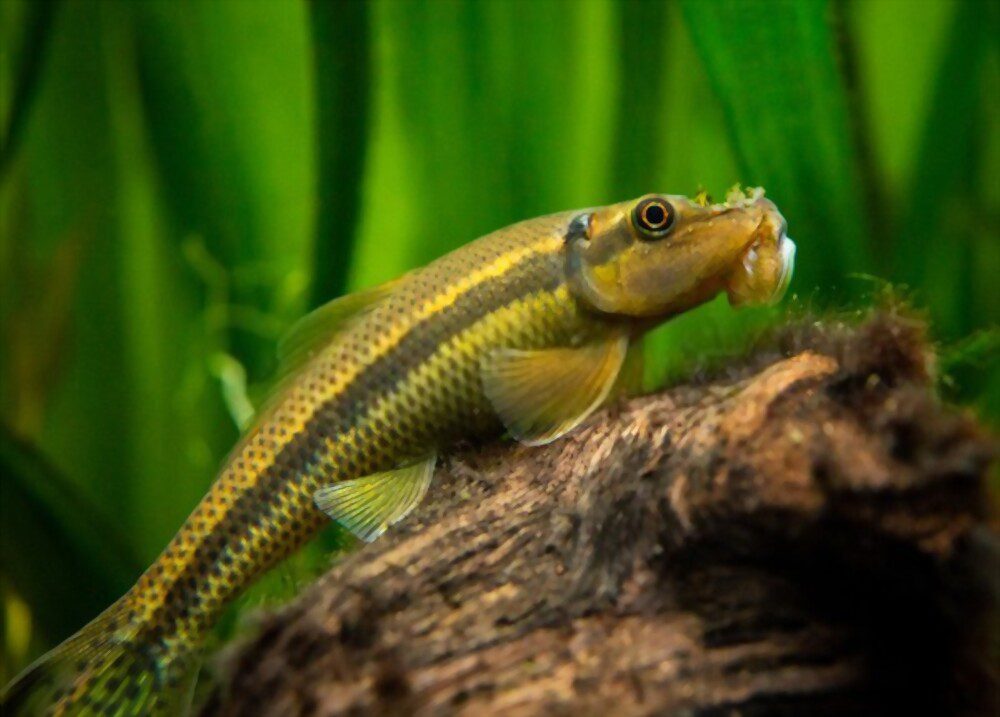
I have used some of these fish successfully for years. I have put together a list of a few of the best fish for eating algae and listed them below:
- Otocinclus Catfish
- Bristlenose Catfish
- Flying Fox Fish
- Siamese Algae Eaters
- Chinese Algae Eaters
- Kuhli Loaches
- Hillstream Loach
- Rosy Barbs
- Amano Shrimp
9- Frequent Water Changes and Tank Maintenance
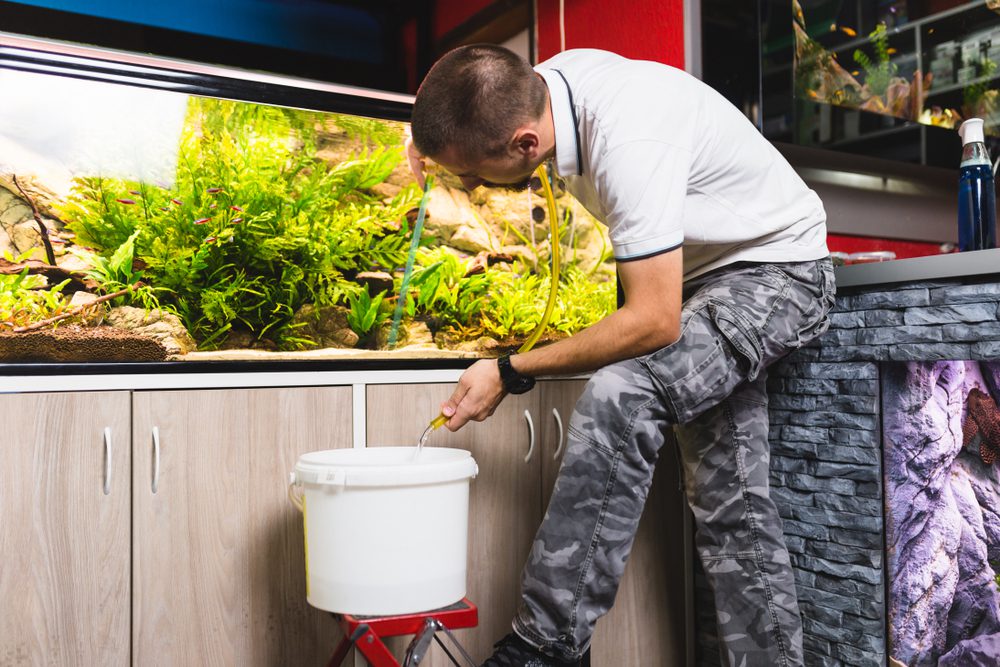
One of the most common causes of green algae freshwater aquarium is that the water becomes stagnant and dirty over time. This happens because the water is not circulated through the tank, which allows algae grow. The algae collect in the corners of your fish tank and on the glass walls.
This can be solved by regularly changing the water in your tank, which will prevent the algae from being able to grow.
How to Remove Green Algae on Aquarium Glass?
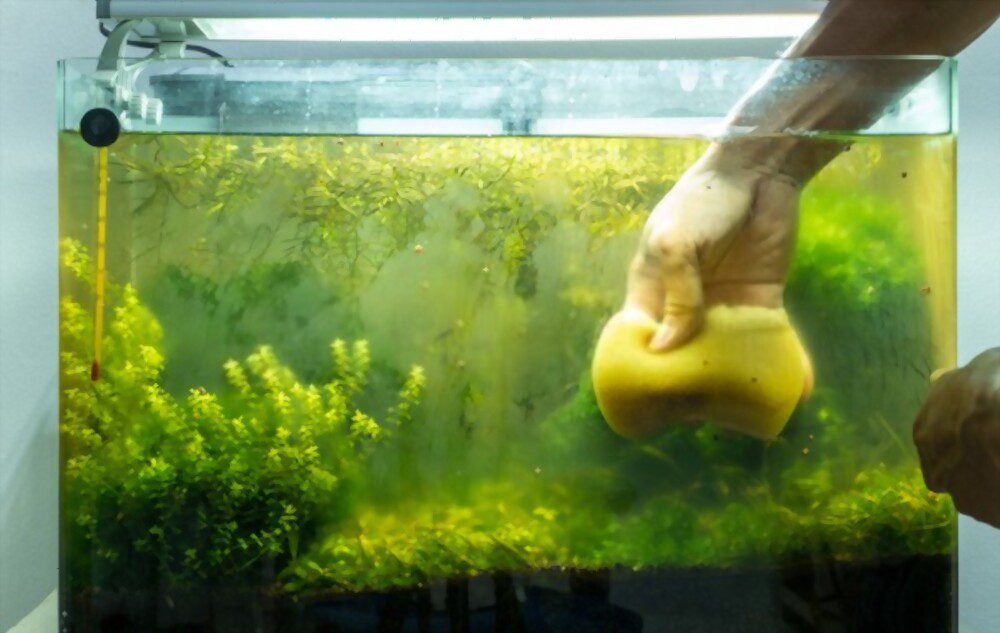
If you have an aquarium and notice a green, slimy substance on your glass, you have a case of green algae. If left alone, the algae grow over your tank and make it harder to see your fish. The good news is that you can remove the green algae without scrubbing it with a razor blade or any other device that can damage your tank.
Note: If you are not sure what you are doing, please consult with a specialist.
Step1- Relocate all of your fish to a safe place and make sure you don’t hurt anyone.
Step2- Turn off all electrical equipment in your aquarium such as heaters, filters, and air pumps. Unplug them from the power source.
Step3- Clean out any loose debris from the bottom of the tank using an aquarium siphon cleaner.
Step4- Add one-half teaspoon of phosphate-free laundry detergent to one gallon of water for every 40 gallons of water in the aquarium.
Step5- Dip a sponge in the solution and wipe away the green algae. Rinse out the sponge frequently to prevent re-contaminating your water with soap suds.
Step6- Change out 10 percent of the water in the aquarium after cleaning it, even if your tank looks clean enough to leave it as is. Because cleaning algae off the glass can raise ammonia and nitrite levels, which are toxic to fish if they get too high too quickly.
Step7- Gently put your fish back in the tank, but before you do that make sure to check the pH level and temperature of your tank water.
How Can I Prevent Algae From Getting into My Aquarium?
You will be thinking are there any natural methods of controlling algae? Is there a way that can prevent algae from getting into my aquarium? so I don’t have to clean it at all.
The truth is, stopping algae from getting into your aquarium is almost an impossible task. However, there are several tips that you can follow to reduce the number of algae getting into your aquarium.
Here are a few tips:
1- Keep Your Tank Covered
If you have a fish tank without a cover that completely seals off the top, you may want to invest in one so that you can protect your fish from jumping out and keep dust and other contaminants out of the water. This will help reduce algae growth by keeping dust off of the surface of your tank.
2- Clean Your Tank Regularly
One of the best ways to prevent algae growth is to keep your tank clean. If you wait too long between cleanings, excess nutrients will build up in the water, encouraging algae growth. The longer they sit in there, the more likely they will be to produce algae. You should aim to clean your aquarium at least once a week, but more often if possible (or if necessary).
3- Maintain the Right pH Level
One way to prevent algae from getting into your aquarium is by making sure your water has the right pH; this will help keep the bacteria that can cause algae growth in check. You can also try using algicides, which are chemicals that inhibit algae growth.
4- Use an Airpump With a Filter
And lastly, make sure to use an air pump with a filter so there won’t be any dead spots where algae could grow unchecked!
Is there any easy way of removing thread algae?
There are several ways to remove thread algae from a tank.
1- Let the Fish Do This For You
The first is to simply let the fish do the work for you. They will usually eat it if they like it. Snails and shrimp will also eat it. There are many species of snails that are carnivores and don’t reproduce in freshwater so they won’t take over your tank like mystery snails or pond snails.
2- Manual Removal
You can also manually remove it with tweezers, but this can be tricky as the threads are extremely fine and break easily. If you want to do this method try to select one of the more robust varieties such as wire or hair algae.
One other method is to use a razor blade. To keep it from scratching your tank, you can either use a plastic scraper or put electrical tape on the blade and then remove the tape once you’re done.
You can also use a toothbrush (preferably an old one) to gently scrub away the algae. A straightened paper clip works well too.
If you don’t want to try any of these methods, you could always buy an algae magnet, which is usually effective against most kinds of algae in tanks.
3- Using Algaecide
Finally, you can use an algaecide, but this should be a last resort as there are no algaecides that will only kill thread algae, they will kill everything else in your tank too!
Can I Use an Algicide to Control Algae?
The simple answer is “Yes”, BUT it should be approached with care as some algaecides can be harmful to fish if not used properly.
Always consult with a specialist if you are not sure what you are doing.
Just to let you know, algaecide is a chemical that can be used to control and kill algae in your aquarium. There are different kinds of algaecides, depending on the type of algae you want to eradicate from your tank. Some algaecides can be used for all types of aquariums while others are specific to saltwater or freshwater tanks.
How to Handle Fish Tank Algae Bloom?
Nitrate is a byproduct of plants that use nitrogen to grow, and some of it ends up in your fish tank as a fertilizer. Your aquarium pump works hard pushing water through the filter and releasing it into the tank. But if there’s too much nitrate (not just more than normal), it can cause algae bloom that quickly covers everything but the filters.
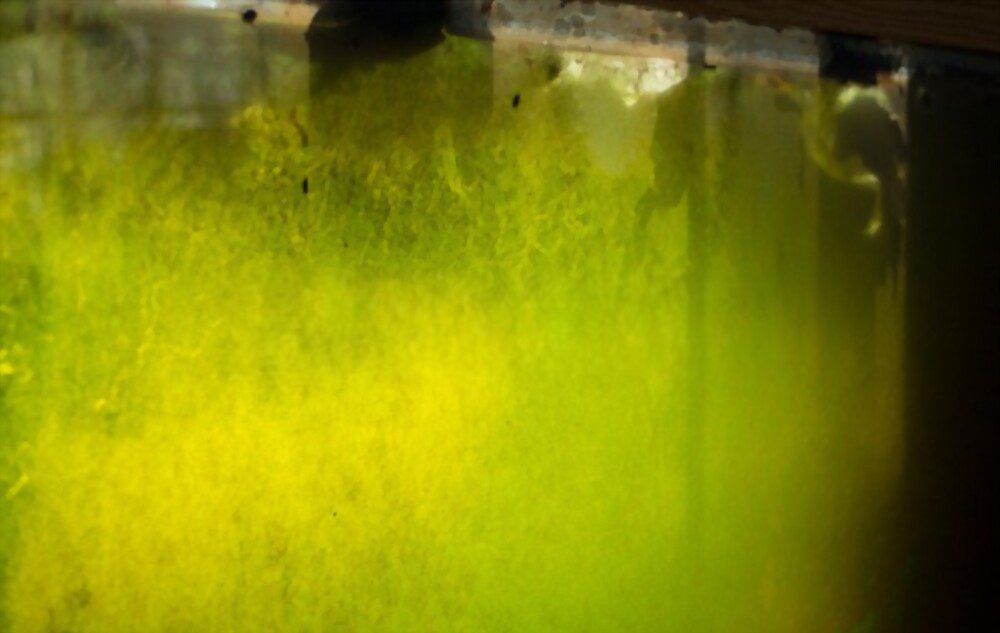
It’s a good idea to properly clean your aquarium so that you keep the nutrients in balance and the water free of debris.
However, if you neglect to remove algae from the water, it will grow into a nasty bloom. The blooms are unsightly and can cause problems for your fish.
If you’re not sure how to handle this problem, you can take the following steps:
Step1- Relocate your aquarium fish to a safe place, and make sure they don’t get hurt.
Step2- Mix 1 tablespoon of bleach in 5 gallons aquarium, use 2 tablespoons if you have 10 gallons aquarium.
Step3- Wait 2 hours before adding any fish to ensure that no algae have grown during this time.
Step4- Use a net or skimmer to remove as much of the algae as possible.
Step5- Change 25 percent of the water in your aquarium every week (and always change out fresh, dechlorinated water).
Moreover, EmeraldSea manufactures a product called Aquatabs that removes nitrogen and phosphates from water and keeps harmful bacteria in check. These products don’t have any negative effects on fish, but they do have a pretty strong chlorine smell.
What do We Think About Green Algae?
Green algae are good for your fish tank. They are a plant so they use CO2 and release oxygen. They also absorb nitrates which are bad for your fish and plants. Algae is not bad it’s just overgrowth of algae that can be bad.
It is important to have balance within your tank, however, so you want to make sure you don’t have too many green algae/too many snails/too much wisteria…
Note: Always consult with the specialist if you are not sure about the problem.
